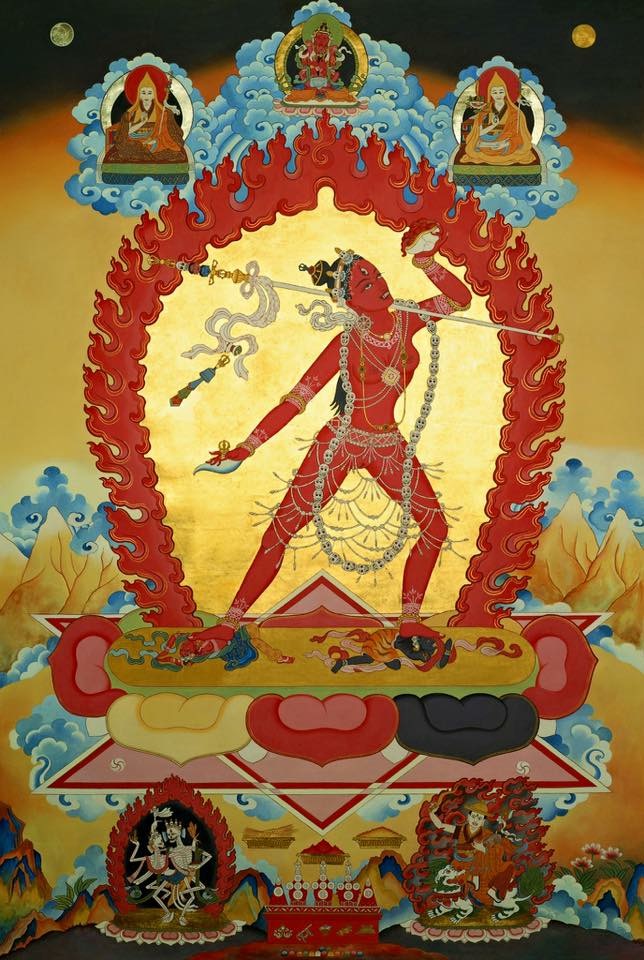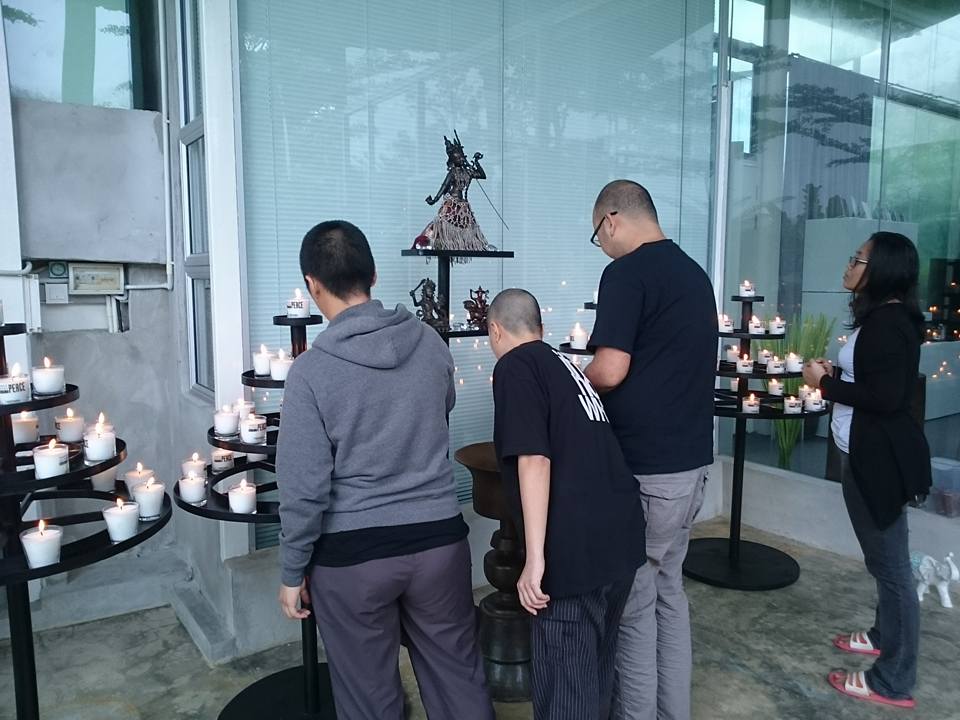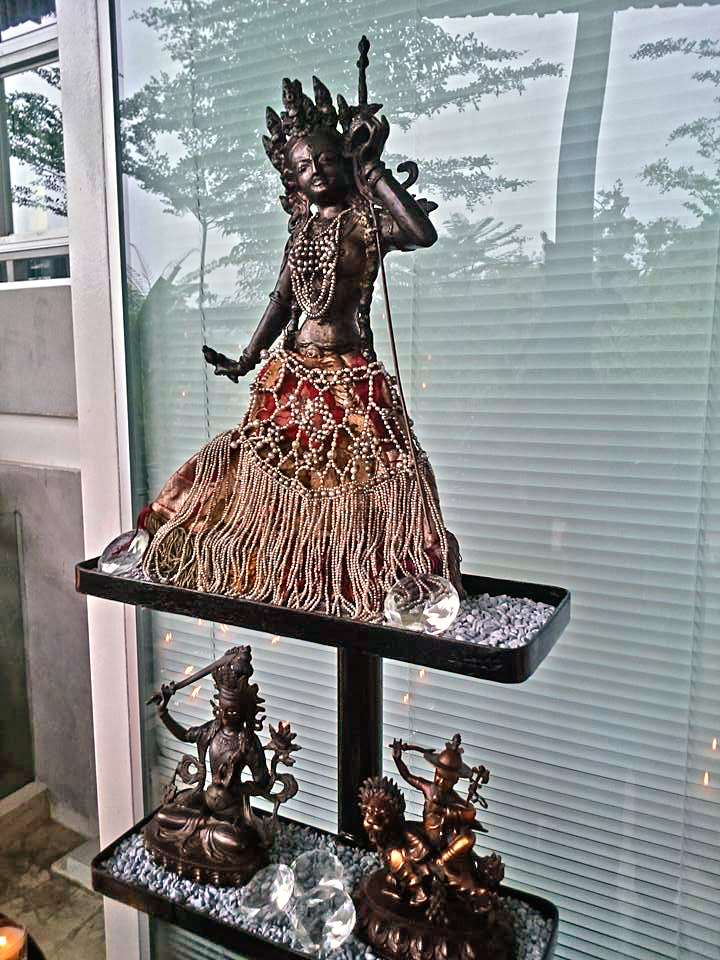Don't try to be right, try to be Vajrayogini
September 28, 2015 4
Rinpoche recently gathered a few of us to give us a mind-blowing teaching (which I will blog about in more detail soon). At the end of the teaching, Rinpoche asked me what my thoughts were. I sort of blabbered and gushed about guru devotion, and I was not coherent. My speech is a reflection of my thoughts so if my speech is unclear, then the thoughts in my mind are as such. Thus in an effort to clarify my own understanding (good luck to me! Haha), I thought I would try and put pen to paper (or rather, fingers to keyboard) before I go to bed so I can revisit my thoughts at a later date.
On our proximity to enlightenment
One of the first points about the teaching that stuck out for me was how close we are to enlightenment. Rinpoche used a common example to demonstrate the strength of our attachments are and how, despite the fact we are so close to the methods that will lead us to enlightenment, we cannot give up our attachments. The example Rinpoche used was smoking; Rinpoche said we are just “one cigarette away from enlightenment”.
As those who smoke (I do not) will know, giving up smoking is not easy for the vast majority of smokers. What is more, the act of smoking has become so normal and unquestioned. Yet when faced with the opportunity to receive higher tantra practices, many of us balk when we are asked to reduce our attachments (let alone give them up completely). The contrast between the apparent mundanity (and yet strength) of our attachments, and the vast and precious opportunity we are giving up just to keep that attachment made me sit up straight.
I understood that the cigarette is just a metaphor for the greater scope of our attachments. We all have attachments and it is not just intoxicant-based. Some of us are attached to money, to shopping, to eating good food, to relationships and having partners. Others are attached to face, to being right, to winning arguments. We can even be attached to our comfort zones which are our habituations, for example flying into a rage every time we are questioned. Why is that an attachment? Because it is much easier for us to get angry than to catch ourselves and stop ourselves from falling into that anger pattern.

A fantastic image of Vajrayogini with the Protector of her practice Cittipati (aka Kinkara, bottom left). Bottom right is Dorje Shugden
So Rinpoche talked about how easily we settle for our bad habits, and yet we think and rethink the good things in our lives which is the Dharma. Why do we rethink Dharma? What is so bad about Dharma that we have to keep examining it? Dharma teaches us to transform our minds, to gain peace, to be kinder, to attain liberation for ourselves and others. On the one hand, we accept bad habits so easily – just one more drink, just one more cigarette, just one more episode of anger – but when our guru asks us to practice the Dharma, we over-examine until our minds go up and down and we are unstable in our practice.
How easily do we fall back to bad habits? How difficult do we find it to change when the truth of the matter is, if you study and meditate and make an effort to practice, transforming your mind is easy because you understand the benefits of doing so (and the disbenefits of not doing so)?
Rinpoche also talked about how he does not care what other people think and that he only cares about what his guru thinks. Why? Because the guru’s opinion arises from enlightenment; friends’ opinions arise from projections and projections only bring suffering. When I brought up this point, Rinpoche elaborated that it is not about being callous or unfeeling towards what everyone else thinks. What Rinpoche meant is that the guru is the Dharma, and the Dharma is the guru; if our behaviour matches up against the Dharma, then the Dharma itself is our guide and teacher (guru). In that case, the physical guru will also be pleased because he / she embodies the Dharma.
Rinpoche said that is why his practice is not dependent on the guru being physically present, because he does not need his teacher to be around in order for him to keep his commitments. It does not mean Rinpoche does not want his teachers to be around. What it does mean is that, that is why over 20 years after Kyabje Zong Rinpoche’s passing, Rinpoche still holds all of his commitments.
So this is my little elaboration which may be mistaken…
What is a friend? In the samsaric world, friends are people we confide in when we are hurt. When we are happy, friends are the people we share our joys with. When we are worried, they are the people we take our problems to. They are our harbour and refuge from the storm…or so we think.
In this case, if the guru is not necessarily the physical guru (but actually the Dharma), then our friends need not necessarily be physical friends either. Our friends can also be the patterns of thinking and reacting we find comforting, which we immediately fall back to when we feel we are being attacked.

Lighting candles at Rinpoche’s outdoor Vajrayogini butter lamp shrine after the teachings. Picture courtesy of Martin Chow (http://www.facebook.com/martin.chow.73)
Someone questioning your judgement? Scowl at them, shout at them, turn your back to them. Someone back-stabbed you at work? Think of ways to get them back, maybe tattle on them to the boss or delay on the next project so they get in trouble, or stop asking them to lunch. Someone took your parking spot? Key their car (okay, a bit drastic).
These thoughts and actions feel familiar to us, and they are our automatic reaction to the events in our lives. This sense of familiarity and our tendency to seek it is akin to running to our friends for comfort when things go wrong.
Therefore when Rinpoche says our friends’ opinions arise from projections, it can be taken to mean our physical friends who are not in the Dharma. Their opinions arise from projections because they do not know any better and therefore, they pull us away from our spiritual practice.
“Friends” can also be taken to mean our comfort zone of falling into old habits of thinking and behaving. These habits or opinions arise from our own projections which lead us to react in destructive ways, therefore also pulling us away from our practice.
In the case of both the physical and metaphorical friend, they are false friends because they lead us away from spirituality. They lead us away from spirituality because they lead us away from methods which will, to put it simply, help us develop a state of mind that is free from suffering. They lead us away from spirituality because their opinions on what to do and how to do it do not arise from an examination of the ultimate truth. They arise from what we perceive as the truth; our perception cannot be trusted because our perception arises from ignorance and a lack of understanding of phenomena. Or to put it more simply – all the projections we ourselves have practiced until the time we met the Dharma has led us to nowhere so clearly, the way we perceive things is wrong and not useful.
What we do not realise is that giving up our attachments and projections and our false friends does not lead us away from who we are; I do not become less Pastor Jean Ai, Ani Pema, etc. In fact, giving these up actually leads us to who we REALLY are which is kindness, clarity, happiness, integrity and perseverance.
On the importance of guru devotion and samaya
Rinpoche spoke about the importance of samaya in relations to Vajrayogini’s practice (which I will elaborate on at a later date, promise!). This was the part I blabbered about – although I received a bit more clarity today about the importance of guru devotion (shenyin tensu) and samaya (damtsik) as the foundation of all attainments, I have not fully grasped the concept yet. It will take some more thinking…and maybe a few more blog posts 😉
Very simplistically, to receive attainments from Vajrayogini’s practice, one of the four prerequisites is clean samaya with our teacher. If we have clean samaya with our teacher and we practice Vajrayogini from His Holiness Kyabje Pabongka Dorjechang’s lineage, then we can ascend to Kechara Paradise (Dakpo Kachö) within seven lifetimes.
It was Vajrayogini herself who promised Kyabje Pabongka Rinpoche that any practitioners who receive and practice her tantra within four generations of Pabongka Rinpoche would ascend to Dakpo Kachö within seven lifetimes. After four generations of practitioners from Pabongka Rinpoche, this reverts to the usual 14 lifetimes.
So this is my little elaboration which may be mistaken…
You may think, “14 lifetimes? All that and it still takes 14 lifetimes? What’s the big deal?” But consider this – one lifetime is not one human lifetime. One lifetime can be the lifetime of a hungry ghost (preta / yidak) who roams for hundreds of years, parched and starving, unable to partake of any sustenance without immense pain and suffering (unless a lama is kind enough to bless and make offerings to provide some relief).
Can you imagine living in such a state for hundreds of years, only to die and whoops – that is one lifetime down, and three aeons of lifetimes to go? Because three great aeons is how long it will take to achieve enlightenment without tantra. For illustration’s sake, three great aeons is the amount of time it takes to empty out a pit of human hair that is one mile wide, one mile deep and one mile long, where every 100 years you uncover the dirt, remove one hair then replace the dirt for another 100 years.
Of course if you practice Vajrayogini well, you will not actually be reborn as a hungry ghost but this example is to illustrate how narrow our concept of “one lifetime” is.

The adamantine crimson goddess herself, Vajrayogini (Neljorma). Picture courtesy of Martin Chow (http://www.facebook.com/martin.chow.73)
So 14 lifetimes versus three aeons is a big deal; seven lifetimes versus 14 lifetimes is a very big deal. And seven lifetimes versus never receiving tantra because Maitreya will not be expounding any tantric teachings makes it a HUGE DEAL to receive Vajrayogini’s practice.
What does all of this gushing about tantric empowerments have to do with guru devotion? If we are devoted to our teachers and we stay close to them spiritually (not necessarily physically), we gain for ourselves the opportunity to receive Vajrayogini’s practice. In that, we gain for ourselves the opportunity to gain attainments, hence guru devotion is the foundation of all attainments as it opens up the doors for us to develop siddhis.
Over and above this, doing the practice well and receiving the lineage of Pabongka Dorjechang means we can ascend to Vajrayogini’s paradise within seven lifetimes, where we will receive teachings from the Queen herself. On ascending to Dakpo Kachö, you are guaranteed never to take rebirth in samsara unless YOU want to, for the benefit of sentient beings.
Now even if we do just the bare minimum and recite her mantra with just faith and guru devotion, which are two of the four commitments, when we ascend to her paradise we will receive teachings to gain attainments like the realisation of emptiness (sunyata / tongpa). That is right; just by reciting her mantra with the four commitments, without any understanding or visualisation whatsoever, we can ascend to Dakpo Kachö. So once again, guru devotion is the foundation of attainments.
On the Eight Worldly Dharmas
When talking about attachments, some mention of the Eight Worldly Dharmas (jigten chögya) must be made. Tonight, Rinpoche directly touched on this topic when Rinpoche talked about how easily offended we are. Rinpoche said that how easily offended a person is, is a reflection of how strongly attached they are.
Do you know people who are always moody, who are depressed, who are known for going on a rampage? Do you know people around whom you have to tiptoe because it seems like the smallest things can set them off? They are the ones who flip the bird when someone cuts them off in traffic, whose faces you check for an expression before approaching them about a sensitive topic, who you dread having to attend meetings with. Even the smallest interactions with them can lead to arguments.
We all know people like that and we all dread being around people like that.
So this is my little elaboration which may be mistaken…
The Eight Worldly Dharmas has been a consistent theme in Rinpoche’s teachings for over a year now, but today gave me a different perspective on the matter.
For whatever reason, when Rinpoche asked us tonight to reflect on how an easily offended person is an attached person, it sunk in very deeply for me. There was a little more clarity and though I would not say I realised anything, I would say it occurred to me how important the other half of the Eight Worldly Dharmas is – our reaction when we are denied something (as opposed to our reaction when we gain something). Both are just as detrimental to our practice as the other.
For the last few weeks, I have been working hard (or so I think!) on catching my mind when any kind of praises are uttered. What I neglected to keep in mind was the other side of the coin; to rid myself of my fear of blame. I told Rinpoche this line particularly struck me because I am a defensive person.
Rinpoche said that is true, one of my gurus is that I hate to be misunderstood. I will reason and clarify and talk until I am sure the other party understands what I really mean. Rinpoche said it is not good or bad; it is simply an intensity that I have allowed to influence my life. What is good is that it can be an intensity that is positive if directed in another way (for example Vajrayogini’s practice) instead of defending my ego.
Rinpoche asked me what will go wrong if I give up this attachment to being understood. What do I get in return if I can do that? I gain Vajrayogini’s practice (or, at the very least, I am closer to gaining Vajrayogini’s practice). And let us say that for whatever reason, at the end we find out Vajrayogini does not really exist. What did we lose by giving up attachments like these? Is it so bad that we became nicer, kinder people? There is no downside to giving up our attachments for Vajrayogini’s practice; the trade-off is so minimal compared to what we actually gain.
That is when Rinpoche said to me, “Don’t try to be right, try to be Vajrayogini.”
Wow, how powerful. Vajrayogini is egolessness. Vajrayogini is renunciation. Vajrayogini is non-attachment. Vajrayogini is bodhicitta. Vajrayogini is wisdom and clarity. To become Vajrayogini is to emulate her qualities more and more; Vajrayogini is above and beyond being ‘right’ which is just so small and mundane next to everything you gain by receiving her practice and becoming more like her, becoming closer to her in terms of emulating her qualities.
I go to bed today with a lot of food for thought and some hopes that this post has been a little helpful to you, as the teaching was for me 🙂
4 Comments → “Don’t try to be right, try to be Vajrayogini”
Leave a Reply to Stella Cancel reply
Recent Posts
Subscribe to Blog
Categories
Archives
Visitors by Country
| Total Pageviews: | 1 |
|---|



Wow, this is profound and very helpful in putting into better perspective of our attachment to our comfort zones; the feelings that we run to whenever we are challenged. Thank You Pastor Jean Ai for sharing.
Wow! Thank you so much Pastor Jean Ai for sharing this teaching from Rinpoche. The last para brought tears to my eyes. Don’t try to be right try to be Vajrayogini !
Thank you !!
Thank you Pastor Jean Ai for sharing your thoughts and teaching from Guru. What is good is that it can be an intensity that is positive if directed in another way…..this phrase ….it just hit right to my head….thank you , thank you.
Really food for thoughts!
1)Is being ‘right’ is more important than having to see the sufferings of the other party when they know that they are wrong?
2)However, if we give in, will it make the other person worst still? These are the questions that I am always ‘bang’ into.
On samaya, how do we know that we have clean samaya or otherwise? Sometimes we think that we might be following instructions, but it could be otherwise.
More thinking needed here. Thanks Pastor for this blogpost.